In previous chapters, we saw that there are no mechanisms in nature to lead the living beings to evolve and that living species came into existence not as the result of an evolutionary process, but rather emerged all of a sudden in their present perfect structure. That is, they were created individually. Therefore, it is obvious that "human evolution", too, is a story that has never taken place.
What, then, do the evolutionists propose as the basis for this story?
This basis is the existence of plenty of fossils on which the evolutionists are able to build up imaginary interpretations. Throughout history, more than 6,000 ape species have lived and most of them have become extinct. Today, only 120 ape species live on the earth. These approximately 6,000 ape species, most of which are extinct, constitute a rich resource for the evolutionists.
The evolutionists wrote the scenario of human evolution by arranging some of the skulls that suited their purpose in an order from the smallest to the biggest and scattering the skulls of some extinct human races among them. According to this scenario, men and today’s apes have common ancestors. These creatures evolved in time and some of them became the apes of today while another group that followed another branch of evolution became the men of today.
However, all the paleontological, anatomical and biological findings have demonstrated that this claim of evolution is as fictitious and invalid as all the others. No sound or real evidence has been put forward to prove that there is a relationship between man and ape, except forgeries, distortions, and misleading drawings and comments.
The fossil record indicates to us that throughout history, men have been men and apes have been apes. Some of the fossils the evolutionists claim to be the ancestors of man, belong to human races that lived until very recently-about 10,000 years ago-and then disappeared. Moreover, many human communities currently living have the same physical appearance and characteristics as these extinct human races, which the evolutionists claim to be the ancestors of men. All these are clear proof that man has never gone through an evolutionary process at any period in history.
The most important of all is that there are numerous anatomical differences between apes and men and none of them are of the kind to come into existence through an evolutionary process. "Bipedality" is one of them. As we will describe later on in detail, bipedality is peculiar to man and it is one of the most important traits that distinguishes man from other animals.
The Darwinist claim holds that today’s man evolved from some kind of ape-like creature. During this alleged evolutionary process, which is supposed to have started from 4 to 5 million years ago, it is claimed that there existed some "transitional forms" between today’s man and his ancestors. According to this completely imaginary scenario, the following four basic "categories" are listed:
1. Australopithecines (any of the various forms belonging to the genus Australopithecus)
2. Homo habilis
3. Homo erectus
4. Homo sapiens
Evolutionists call the genus to which the alleged ape-like ancestors of man belonged "Australopithecus", which means "southern ape". Australopithecus, which is nothing but an old type of ape that has become extinct, is found in various different forms. Some of them are larger and strongly built (robust), while others are smaller and delicate (gracile).
Evolutionists classify the next stage of human evolution as the genus Homo, that is "man". According to the evolutionist claim, the living things in the Homo series are more developed than Australopithecus, and not very much different from today’s man. The man of our day, that is, the species Homo sapiens, is said to have formed at the latest stage of the evolution of this genus Homo.
Fossils like "Java Man", "Pekin Man", and "Lucy", which appear in the media from time to time and are to be found in evolutionist publications and textbooks, are included in one of the four groups listed above. Each of these groupings is also assumed to branch into species and sub-species, as the case may be.
Some suggested transitional forms of the past, such as Ramapithecus, had to be excluded from the imaginary human family tree after it was realised that they were ordinary apes.71
By outlining the links in the chain as "australopithecines > Homo habilis > Homo erectus > Homo sapiens", the evolutionists imply that each of these types is the ancestor of the next. However, recent findings by paleoanthropologists have revealed that australopithecines, Homo habilis and Homo erectus existed in different parts of the world at the same time. Moreover, some of those humans classified as Homo erectus probably lived up until very recent times. In an article titled "Latest Homo erectus of Java: Potential Contemporaneity with Homo sapiens in Southeast Asia", it was reported in the journal Science that Homo erectus fossils found in Java had "mean ages of 27 ± 2 to 53.3 ± 4 thousand years ago" and this "raise[s] the possibility that H. erectus overlapped in time with anatomically modern humans (H. sapiens) in Southeast Asia".
A Single Jawbone As a Spark of Inspiration | ||
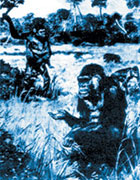  | 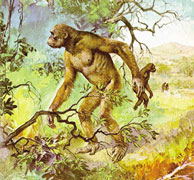  | 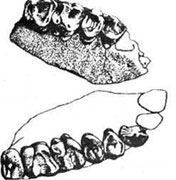 |
The evolutionists daringly pictured Ramapithecus, his family and the environment they lived in, by relying only on these jawbones. | The first Ramapithecus fossil found: A missing jaw composed of two parts. | |
Furthermore, Homo sapiens neandarthalensis and Homo sapiens sapiens (today’s man) also clearly co-existed. This situation apparently indicates the invalidity of the claim that one is the ancestor of the other.
Intrinsically, all findings and scientific research have revealed that the fossil record does not suggest an evolutionary process as evolutionists propose. The fossils, which evolutionists claim to be the ancestors of humans, in fact belong either to different human races, or else to species of ape.
Then which fossils are human and which ones are apes? Is it ever possible for any one of them to be considered a transitional form? In order to find the answers, let us have a closer look at each category.
The first category, the genus Australopithecus, means "southern ape", as we have said. It is assumed that these creatures first appeared in Africa about 4 million years ago, and lived until 1 million years ago. There are a number of different species among the astralopithecines. Evolutionists assume that the oldest Australopithecus species is A. Afarensis. After that comes A. Africanus, and then A. Robustus, which has relatively bigger bones. As for A. Boisei, some researchers accept it as a different species, and others as a sub-species of A. Robustus.
All of the Australopithecus species are extinct apes that resemble the apes of today. Their cranial capacities are the same or smaller than the chimpanzees of our day. There are projecting parts in their hands and feet which they used to climb trees, just like today's chimpanzees, and their feet are built for grasping to hold onto branches. They are short (maximum 130 cm. (51 in.)) and just like today's chimpanzees, male Australopithecus is larger than the female. Many other characteristics-such as the details in their skulls, the closeness of their eyes, their sharp molar teeth, their mandibular structure, their long arms, and their short legs-constitute evidence that these creatures were no different from today's ape.
However, evolutionists claim that, although australopithecines have the anatomy of apes, unlike apes, they walked upright like humans.
Australopithecus Aferensis: An Extinct Ape | |||
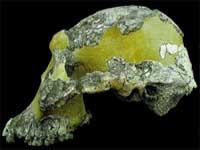 | Below is seen the skull of Australopithecus aferensis AL 444-2 fossil, and Above is the skull of a contemporary ape. The obvious similarity verifies that A. aferensis is an ordinary ape species without any "human-like" features.
|  | The first fossil found in Ethiopia, Hadar, which is to be supposed to belong to Australopithecus aferensis species: AL 288-1 or "Lucy". For a long time, evolutionists struggled to prove that Lucy could walk upright; but the latest research has definitely established that this animal was an ordinary ape with a bent stride. The Australopithecus aferensis AL 333-105 fossil seen below belongs to a young member of this species. This is why the protrusion has not yet formed on his skull. |
Upper : Australopithecus | |||
 | |||
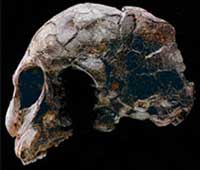 | |||
This claim that australopithecines walked upright is a view that has been held by paleoanthropologists such as Richard Leakey and Donald C. Johanson for decades. Yet many scientists who have carried out a great deal of research on the skeletal structures of australopithecines have proved the invalidity of that argument. Extensive research done on various Australopithecus specimens by two world-renowned anatomists from England and the USA, Lord Solly Zuckerman and Prof. Charles Oxnard, showed that these creatures did not walk upright in human manner. Having studied the bones of these fossils for a period of 15 years thanks to grants from the British government, Lord Zuckerman and his team of five specialists reached the conclusion that australopithecines were only an ordinary ape genus and were definitely not bipedal, although Zuckerman is an evolutionist himself.72Correspondingly, Charles E. Oxnard, who is another evolutionist famous for his research on the subject, also likened the skeletal structure of australopithecines to that of today’s orang-utans.73
The fact that Australopithecus cannot be considered an ancestor of man is also accepted by evolutionist sources. The well-known French magazine Science et Vie made this its cover story of its May 1999 issue. The story dealt with Lucy, the best-known fossil specimen of Australopithecus afarensis, under the title "Adieu Lucy," (Goodbye Lucy) and wrote of the need to remove Australopithecus from the human family tree. The article, based on the discovery of a new Australopithecus, code number St W573, stated:
A new theory states that the genus Australopithecus is not the root of the human race… The results arrived at by the only woman authorized to examine St W573 are different from the normal theories regarding mankind's ancestors: this destroys the hominid family tree. Large primates, considered the ancestors of man, have been removed from the equation of this family tree… Australopithecus and Homo (human) species do not appear on the same branch. Man's direct ancestors are still waiting to be discovered.74
The great similarity between the skeletal and cranial structures of australopithecines and chimpanzees, and the refutation of the claim that these creatures walked upright, have caused great difficulty for evolutionist paleoanthropologists. The reason is that, according to the imaginary evolution scheme, Homo erectus comes after Australopithecus. As the genus name Homo (meaning "man") implies, Homo erectus is a human species and its skeleton is straight. Its cranial capacity is twice as large as that of Australopithecus. A direct transition from Australopithecus, which is a chimpanzee-like ape, to Homo erectus, which has a skeleton no different from today’s man's, is out of the question even according to evolutionist theory. Therefore, "links"-that is, "transitional forms"-are needed. The concept of Homo habilis arose from this necessity.
The classification of Homo habilis was put forward in the 1960s by the Leakeys, a family of "fossil hunters". According to the Leakeys, this new species, which they classified as Homo habilis, had a relatively large cranial capacity, the ability to walk upright and to use stone and wooden tools. Therefore, it could have been the ancestor of man.
Homo Habilis: Another Extinct Ape | |
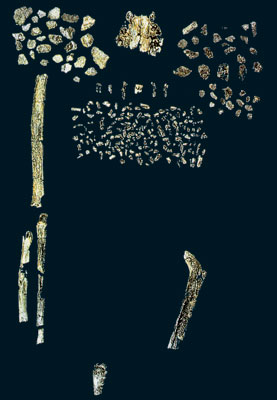 | For a long time, evolutionists argued that the creatures they called Homo habilis could walk upright. They thought that they had found a link stretching from ape to man. Yet, the new Homo habilis fossils Tim White unearthed in 1986 and named as OH 62 disproved this assertion. These fossil fragments showed that Homo habilis had long arms and short legs just like contemporary apes. This fossil put an end to the assertion proposing that Homo habilis was a bipedal being able to walk upright. In truth, Homo habilis was nothing but another ape species. 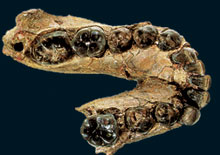 "OH 7 Homo habilis" seen on the down left has been the fossil which best defined the mandibular features of the Homo habilis species. This mandible fossil has big incisory teeth. Its molar teeth are small. The shape of the mandible is square. All these qualities make this mandible look very similar to that of today's apes. In other words, Homo habilis' mandible once more confirms that this being is actually an ape. |
New fossils of the same species unearthed in the late 1980s, were to completely change this view. Some researchers, such as Bernard Wood and C. Loring Brace, who relied on those newly-found fossils, stated that Homo habilis (which means "skillful man", that is, man capable of using tools) should be classified as Australopithecus habilis, or "skillful southern ape", because Homo habilis had a lot of characteristics in common with the australopithecine apes. It had long arms, short legs and an ape-like skeletal structure just like Australopithecus. Its fingers and toes were suitable for climbing. Their jaw was very similar to that of today's apes. Their 600 cc average cranial capacity is also an indication of the fact that they were apes. In short, Homo habilis, which was presented as a different species by some evolutionists, was in reality an ape species just like all the other australopithecines.
Research carried out in the years since Wood and Brace's work has demonstrated that Homo habilis was indeed no different from Australopithecus. The skull and skeletal fossil OH62 found by Tim White showed that this species had a small cranial capacity, as well as long arms and short legs which enabled them to climb trees just like apes of our day do.
The detailed analyses conducted by American anthropologist Holly Smith in 1994 indicated that Homo habilis was not Homo, in other words, "human", at all, but rather unequivocally an "ape". Speaking of the analyses she made on the teeth of Australopithecus, Homo habilis, Homo erectus and Homo neanderthalensis, Smith stated the following;
Restricting analysis of fossils to specimens satisfying these criteria, patterns of dental development of gracile australopithecines and Homo Habilis remain classified with African apes. Those of Homo erectus and Neanderthals are classified with humans.75
Within the same year, Fred Spoor, Bernard Wood and Frans Zonneveld, all specialists on anatomy, reached a similar conclusion through a totally different method. This method was based on the comparative analysis of the semi-circular canals in the inner ear of humans and apes which provided for sustaining balance. Spoor, Wood and Zonneveld concluded that:
Among the fossil hominids the earliest species to demonstrate the modern human morphology is Homo erectus. In contrast, the semi-circular canal dimensions in crania from southern Africa attributed to Australopithecus and Paranthropus resemble those of the extant great apes.76
Spoor, Wood and Zonneveld also studied a Homo habilis specimen, namely Stw 53, and found out that "Stw 53 relied less on bipedal behavior than the australopithecines." This meant that the H. habilis specimen was even more ape-like than the Australopithecus species. Thus they concluded that "Stw 53 represents an unlikely intermediate between the morphologies seen in the australopithecines and H. erectus."
This finding yielded two important results:
1. Fossils referred to as Homo habilis did not actually belong to the genus Homo, i.e. humans, but to that of Australopithecus, i.e. apes.
2. Both Homo habilis and Australopithecus were creatures that walked stooped forward-that is to say, they had the skeleton of an ape. They have no relation whatsoever to man.
There was | |
 | |
1. Semicircular Canals | 6. Endolymph-filled Canals |
A comparative analysis of the semi-circular canals in the inner ear in both humans and apes shows that the fossils long portrayed as the forerunners of human beings were all in fact ordinary apes. The species Australopithecus and Homo habilis had the inner ear canals of an ape, while Homo erectus had human ones. | |
The term Homo rudolfensis is the name given to a few fossil fragments unearthed in 1972. The species supposedly represented by this fossil was designated Homo rudolfensis because these fossil fragments were found in the vicinity of Lake Rudolf in Kenya. Most of the paleoanthropologists accept that these fossils do not belong to a distinct species, but that the creature called Homo rudolfensis is in fact indistinguishable from Homo habilis.
Richard Leakey, who unearthed the fossils, presented the skull designated "KNM-ER 1470", which he said was 2.8 million years old, as the greatest discovery in the history of anthropology. According to Leakey, this creature, which had a small cranial capacity like that of Australopithecus together with a face similar to that of present-day humans, was the missing link between Australopithecus and humans. Yet, after a short while, it was realised that the human-like face of the KNM-ER 1470 skull, which frequently appeared on the covers of scientific journals and popular science magazines was the result of the incorrect assembly of the skull fragments, which may have been deliberate. Professor Tim Bromage, who conducts studies on human facial anatomy, brought this to light by the help of computer simulations in 1992:
When it [KNM-ER 1470] was first reconstructed, the face was fitted to the cranium in an almost vertical position, much like the flat faces of modern humans. But recent studies of anatomical relationships show that in life the face must have jutted out considerably, creating an ape-like aspect, rather like the faces of Australopithecus.77
The evolutionist paleoanthropologist J. E. Cronin states the following on the matter:
... its relatively robustly constructed face, flattish naso-alveolar clivus, (recalling australopithecine dished faces), low maximum cranial width (on the temporals), strong canine juga and large molars (as indicated by remaining roots) are all relatively primitive traits which ally the specimen with members of the taxon A. africanus.78
C. Loring Brace from Michigan University came to the same conclusion. As a result of the analyses he conducted on the jaw and tooth structure of skull 1470, he reported that "from the size of the palate and the expansion of the area allotted to molar roots, it would appear that ER 1470 retained a fully Australopithecus-sized face and dentition".79
Professor Alan Walker, a paleoanthropologist from Johns Hopkins University who has done as much research on KNM-ER 1470 as Leakey, maintains that this creature should not be classified as a member of Homo-i.e., as a human species-but rather should be placed in the Australopithecus genus.80
In summary, classifications like Homo habilis or Homo rudolfensis which are presented as transitional links between the australopithecines and Homo erectus are entirely imaginary. It has been confirmed by many researchers today that these creatures are members of the Australopithecus series. All of their anatomical features reveal that they are species of ape.
This fact has been further established by two evolutionist anthropologists, Bernard Wood and Mark Collard, whose research was published in 1999 in Science magazine. Wood and Collard explained that the Homo habilis and Homo rudolfensis (Skull 1470) taxa are imaginary, and that the fossils assigned to these categories should be attributed to the genus Australopithecus:
More recently, fossil species have been assigned to Homo on the basis of absolute brain size, inferences about language ability and hand function, and retrodictions about their ability to fashion stone tools. With only a few exceptions , the definition and use of the genus within human evolution, and the demarcation of Homo, have been treated as if they are unproblematic. But ... recent data, fresh interpretations of the existing evidence, and the limitations of the paleoanthropological record invalidate existing criteria for attributing taxa to Homo.
...in practice fossil hominin species are assigned to Homo on the basis of one or more out of four criteria. ... It is now evident, however, that none of these criteria is satisfactory. The Cerebral Rubicon is problematic because absolute cranial capacity is of questionable biological significance. Likewise, there is compelling evidence that language function cannot be reliably inferred from the gross appearance of the brain, and that the language-related parts of the brain are not as well localized as earlier studies had implied...
...In other words, with the hypodigms of H. habilis and H. rudolfensis assigned to it, the genus Homo is not a good genus. Thus, H. habilis and H. rudolfensis (or Homo habilis sensu lato for those who do not subscribe to the taxonomic subdivision of "early Homo") should be removed from Homo. The obvious taxonomic alternative, which is to transfer one or both of the taxa to one of the existing early hominin genera, is not without problems, but we recommend that, for the time being, both H. Habilis and H. Rudolfensis should be transferred to the genus Australopithecus.81
The conclusion of Wood and Collard corroborates the conclusion we have maintained here:"Primitive human ancestors" do not exist in history. Creatures that are alleged to be so are actually apes that ought to be assigned to the genus Australopithecus. The fossil record shows that there is no evolutionary link between these extinct apes and Homo, i.e., human species that suddenly appears in the fossil record.
700 Thousand Year Old Mariners |
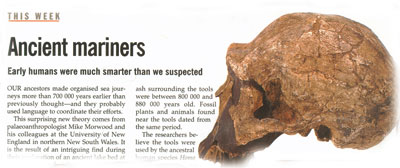 |
"Early humans were much smarter than we suspected..." News published in New Scientist on March 14th 1998 tells us that the humans called Homo Erectus by evolutionists were practicing seamanship 700 thousand years ago. These humans, who had enough knowledge and technology to build a vessel and possess a culture that made use of sea transport, can hardly be called "primitive". |
According to the fanciful scheme suggested by evolutionists, the internal evolution of the Homo genus is as follows: First Homo erectus, then so-called "archaic" Homo sapiens and Neanderthal man (Homo sapiens neanderthalensis), and finally, Cro-Magnon man (Homo sapiens sapiens). However all these classifications are really only variations and unique races in the human family. The difference between them is no greater than the difference between an Inuit and an African or a pygmy and a European.
Let us first examine Homo erectus, which is referred to as the most primitive human species. As the name implies, "Homo erectus" means "man who walks upright". Evolutionists have had to separate these fossils from earlier ones by adding the qualification of "erectness", because all the available Homo erectus fossils are straight to an extent not observed in any of the australopithecines or so-called Homo habilis specimens. There is no difference between the postcranial skeleton of today’s man and that of Homo erectus.
The primary reason for evolutionists' defining Homo erectus as "primitive", is the cranial capacity of its skull (900-1,100 cc), which is smaller than the average man of our day, and its thick eyebrow projections. However, there are many people living today in the world who have the same cranial capacity as Homo erectus (pygmies, for instance) and other races have protruding eyebrows (Native Australians, for instance).
It is a commonly agreed-upon fact that differences in cranial capacity do not necessarily denote differences in intelligence or abilities. Intelligence depends on the internal organisation of the brain, rather than on its volume.82
The fossils that have made Homo erectus known to the entire world are those of Peking man and Java man in Asia. However, in time it was realised that these two fossils are not reliable. Peking Man consists of some elements made of plaster whose originals have been lost, and Java Man is "composed" of a skull fragment plus a pelvic bone that was found metres away from it with no indication that these belonged to the same creature. This is why the Homo erectus fossils found in Africa have gained such increasing importance. (It should also be noted that some of the fossils said to be Homo erectus were included under a second species named "Homo ergaster" by some evolutionists. There is disagreement among the experts on this issue. We will treat all these fossils under the classification of Homo erectus)
Homo erectus: A Real Human Race | ||
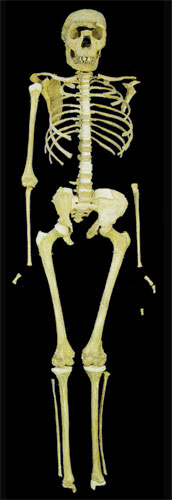 |  | 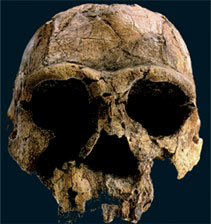 |
Homo erectus means "upright man". All the fossils included in this species belong to particular human races. Since most of the Homo erectus fossils do not have a common characteristic, it is quite hard to define these men according to their skulls. This is the reason why different evolutionist researchers have made various classifications and designations. Above left is seen a skull which was found in Koobi Fora, Africa in 1975 which may generally define Homo erectus. Above right is a skull, Homo ergaster KNM-ER 3733, which has the obscurities in question. The cranial capacities of all these diverse Homo erectus fossils surge between 900-1100 cc. These figures are within the limits of the contemporary human cranial capacity. KNM-WT 15000 or Turkana Child skeleton on the right, is probably the oldest and the most complete human fossil ever found. Research made on this fossil which is said to be 1.6 million year old shows that this belongs to a 12 year old child who would become around 1.80 m. tall if he reached adolescence. This fossil which very much resembled to the Neanderthal race, is one of the most remarkable evidence invalidating the story of human's evolution. | ||
The evolutionist Donald Johnson describes this fossil as follows: "He was tall and skinny. His body shape and the proportion of his limbs were the same as the current Equator Africans. The sizes of his limbs totally matched with that of the current white North American adults." (Donald C. Johanson & M. A. Edey, Lucy: The Beginnings of Humankind, New York: Simon & Schuster, 1981) | ||
The most famous of the Homo erectus specimens found in Africa is the fossil of "Narikotome Homo erectus" or the "Turkana Boy" which was found near Lake Turkana in Kenya. It is confirmed that the fossil was that of a 12-year-old boy, who would have been 1.83 meters tall in adolescence. The upright skeletal structure of the fossil is no different from that of contemporary man. The American paleoanthropologist Alan Walker said that he doubted that "the average pathologist could tell the difference between the fossil skeleton and that of a modern human."83 Concerning the skull, Walker wrote that he laughed when he saw it because "it looked so much like a Neanderthal."84As we will see in the next chapter, Neanderthals are a modern human race. Therefore, Homo erectus is also a modern human race.
Even the evolutionist Richard Leakey states that the differences between Homo erectus and modern man are no more than racial variance:
One would also see differences in the shape of the skull, in the degree of protrusion of the face, the robustness of the brows and so on. These differences are probably no more pronounced than we see today between the separate geographical races of modern humans. Such biological variation arises when populations are geographically separated from each other for significant lengths of time.85
Professor William Laughlin from the University of Connecticut made extensive anatomical examinations of Inuits and the people living on the Aleut islands, and noticed that these people were extraordinarily similar to Homo erectus. The conclusion Laughlin arrived at was that all these distinct races were in fact different races of Homo sapiens (today’s man).
When we consider the vast differences that exist between remote groups such as Eskimos and Bushmen, who are known to belong to the single species of Homo sapiens, it seems justifiable to conclude that Sinanthropus [an erectus specimen] belongs within this same diverse species.86
It is now a more pronounced fact in the scientific community that Homo erectus is a superfluous taxon, and that fossils assigned to the Homo erectus class are actually not so different from Homo sapiens as to be considered a different species. In American Scientist, the discussions over this issue and the result of a conference held on the subject in 2000 were summarised in this way:
Most of the participants at the Senckenberg conference got drawn into a flaming debate over the taxonomic status of Homo erectus started by Milford Wolpoff of the University of Michigan, Alan Thorne of the University of Canberra and their colleagues. They argued forcefully that Homo erectus had no validity as a species and should be eliminated altogether. All members of the genus Homo, from about 2 million years ago to the present, were one highly variable, widely spread species, Homo sapiens, with no natural breaks or subdivisions. The subject of the conference, Homo erectus didn't exist.87
The conclusion reached by the scientists defending the abovementioned thesis can be summarised as "Homo erectus is not a different species from Homo sapiens, but rather a race within Homo sapiens".
On the other hand, there is a huge gap between Homo erectus, a human race, and the apes that preceded Homo erectus in the "human evolution" scenario, (Australopithecus, Homo Habilis, and Homo rudolfensis). This means that the first men appeared in the fossil record suddenly and without any prior evolutionary history. This is a most clear indication of their being created.
Yet, admitting this fact is totally against the dogmatic philosophy and ideology of evolutionists. As a result, they try to portray Homo erectus, a truly human race, as a half-ape creature. In their Homo erectus reconstructions, they tenaciously draw simian features. On the other hand, with similar drawing methods, they humanise apes like Australopithecus or Homo Habilis. With this method, they seek to "approximate" apes and human beings and close the gap between these two distinct living classes.
  |
FALSE MASKS: |
Neanderthals were human beings who suddenly appeared 100,000 years ago in Europe, and who disappeared, or were assimilated by mixing with other races, quietly but quickly 35,000 years ago. Their only difference from man of our day is that their skeletons are more robust and their cranial capacity slightly bigger.
Neanderthals were a human race, a fact which is admitted by almost everybody today. Evolutionists have tried very hard to present them as a "primitive species", yet all the findings indicate that they were no different from a "robust" man walking on the street today. A prominent authority on the subject, Erik Trinkaus, a paleoanthropologist from New Mexico University writes:
Detailed comparisons of Neanderthal skeletal remains with those of modern humans have shown that there is nothing in Neanderthal anatomy that conclusively indicates locomotor, manipulative, intellectual, or linguistic abilities inferior to those of modern humans.88
Many contemporary researchers define Neanderthal man as a sub-species of present-day man and call him "Homo sapiens neandertalensis". The findings testify that Neanderthals buried their dead, fashioned musical instruments, and had cultural affinities with the Homo sapiens sapiens living during the same period. To put it precisely, Neanderthals are a "robust" human race that simply disappeared in time.
Neanderthals: A Robust People | |
 | 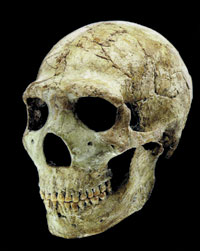 Above is seen Homo sapiens Neanderthalensis, Amud 1 skull found in Israel. Neanderthal man is generally known to be robust yet short. However it is estimated that the owner of this fossil had been 1.80 m. high. His cranial capacity is the largest ever seen: 1740cc. Because of all these, this fossil is among the important pieces of evidence definitely destroying the claims that Neanderthals were a primitive species. Above is seen Homo sapiens Neanderthalensis, Amud 1 skull found in Israel. Neanderthal man is generally known to be robust yet short. However it is estimated that the owner of this fossil had been 1.80 m. high. His cranial capacity is the largest ever seen: 1740cc. Because of all these, this fossil is among the important pieces of evidence definitely destroying the claims that Neanderthals were a primitive species.
|
Archaic Homo sapiens is the last step before contemporary man in the imaginary evolutionary scheme. In fact, evolutionists do not have much to say about these fossils, as there are only very minor differences between them and today’s human beings. Some researchers even state that representatives of this race are still living today, and point to native Australians as an example. Like Homo sapiens (archaic), native Australians also have thick protruding eyebrows, an inward-inclined mandibular structure, and a slightly smaller cranial capacity.
The group characterised as Homo heilderbergensis in evolutionist literature is in fact the same as archaic Homo sapiens. The reason why two different terms are used to define the same human racial type is the disagreements among evolutionists. All the fossils included under the Homo heidelbergensis classification suggest that people who were anatomically very similar to today’s Europeans lived 500,000 and even 740,000 years ago, first in England and then in Spain.
It is estimated that Cro-Magnon man lived 30,000 years ago. He has a dome-shaped cranium and a broad forehead. His cranium of 1,600 cc is above the average for contemporary man. His skull has thick eyebrow projections and a bony protrusion at the back that is characteristic of both Neanderthal man and Homo erectus.
Although the Cro-Magnon is considered to be a European race, the structure and volume of Cro-Magnon's cranium look very much like those of some races living in Africa and the tropics today. Relying on this similarity, it is estimated that Cro-Magnon was an archaic African race. Some other paleoanthropological finds have shown that the Cro-Magnon and the Neanderthal races intermixed and laid the foundations for the races of our day.
As a result, none of these human beings were "primitive species". They were different human beings who lived in earlier times and either assimilated and mixed with other races, or became extinct and disappeared from history.
26.000 Year Old Needle |
 |
An interesting fossil showing that the Neanderthals had knowledge of clothing: A needle 26,000 years old. (D. Johanson, B. Edgar From Lucy to Language, p. 99) |
What we have investigated so far forms a clear picture: The scenario of "human evolution" is a complete fiction. In order for such a family tree to represent the truth, a gradual evolution from ape to man must have taken place and a fossil record of this process should be able to be found. In fact, however, there is a huge gap between apes and humans. Skeletal structures, cranial capacities, and such criteria as walking upright or bent sharply forward distinguish humans from apes. (We already mentioned that on the basis of recent research done in 1994 on the inner ear, Australopithecus and Homo habilis were reclassified as apes, while Homo erectus was reclassified as a fully modern human.)
Another significant finding proving that there can be no family-tree relationship among these different species is that species that are presented as ancestors of others in fact lived concurrently. If, as evolutionists claim, Australopithecus changed into Homo habilis, which, in turn, turned into Homo erectus, the periods they lived in should necessarily have followed each other. However, there is no such chronological order to be seen in the fossil record.
According to evolutionist estimates, Australopithecus lived from 4 million up until 1 million years ago. The creatures classified as Homo habilis, on the other hand, are thought to have lived until 1.7 to 1.9 million years ago. Homo rudolfensis, which is said to have been more "advanced" than Homo habilis, is known to be as old as from 2.5 to 2.8 million years! That is to say, Homo rudolfensis is nearly 1 million years older than Homo habilis, of which it is alleged to have been the "ancestor". On the other hand, the age of Homo erectus goes as far back as 1.6-1.8 million years ago, which means that Homo erectus appeared on the earth in the same time frame as its so-called ancestor, Homo habilis.
Alan Walker confirms this fact by stating that "there is evidence from East Africa for late-surviving small Australopithecus individuals that were contemporaneous first with H. Habilis, then with H. erectus."89Louis Leakey has found fossils of Australopithecus, Homo habilis and Homo erectus almost next to each other in the Olduvai Gorge region of Tanzania, in the Bed II layer.90
There is definitely no such family tree. Stephen Jay Gould, who was a paleontologist from Harvard University, explained this deadlock faced by evolution, although he was an evolutionist himself:
What has become of our ladder if there are three coexisting lineages of hominids (A. africanus, the robust australopithecines, and H. habilis), none clearly derived from another? Moreover, none of the three display any evolutionary trends during their tenure on earth.91
When we move on from Homo erectus to Homo sapiens, we again see that there is no family tree to talk about. There is evidence showing that Homo erectus and archaic Homo sapiens continued living up to 27,000 years and even as recently as 10,000 years before our time. In the Kow Swamp in Australia, some 13,000-year-old Homo erectus skulls have been found. On the island of Java, Homo erectus remains were found that are 27,000 years old.92
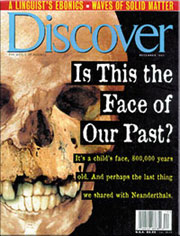 |
One of the most popular periodicals of the evolutionist literature, Discover, put the 800 thousand-year-old human face on its cover with the evolutionists' question "Is this the face of our past?". |
The most interesting and significant fact that nullifies the very basis of the imaginary family tree of evolutionary theory is the unexpectedly ancient history of man. Paleoanthropological findings reveal that Homo sapiens people who looked exactly like us were living as long as 1 million years ago.
It was Louis Leakey, the famous evolutionist paleoanthropologist, who discovered the first findings on this subject. In 1932, in the Kanjera region around Lake Victoria in Kenya, Leakey found several fossils that belonged to the Middle Pleistocene and that were no different from today’s man. However, the Middle Pleistocene was a million years ago.93Since these discoveries turned the evolutionary family tree upside down, they were dismissed by some evolutionist paleoanthropologists. Yet Leakey always contended that his estimates were correct.
Just when this controversy was about to be forgotten, a fossil unearthed in Spain in 1995 revealed in a very remarkable way that the history of Homo sapiens was much older than had been assumed. The fossil in question was uncovered in a cave called Gran Dolina in the Atapuerca region of Spain by three Spanish paleoanthropologists from the University of Madrid. The fossil revealed the face of an 11-year-old boy who looked entirely like man of our day. Yet, it had been 800,000 years since the child died. Discover magazine covered the story in great detail in its December 1997 issue.
This fossil even shook the convictions of Juan Luis Arsuaga Ferreras, who lead the Gran Dolina excavation. Ferreras said:
We expected something big, something large, something inflated-you know, something primitive. Our expectation of an 800,000-year-old boy was something like Turkana Boy. And what we found was a totally modern face.... To me this is most spectacular-these are the kinds of things that shake you. Finding something totally unexpected like that. Not finding fossils; finding fossils is unexpected too, and it's okay. But the most spectacular thing is finding something you thought belonged to the present, in the past. It's like finding something like-like a tape recorder in Gran Dolina. That would be very surprising. We don't expect cassettes and tape recorders in the Lower Pleistocene. Finding a modern face 800,000 years ago-it's the same thing. We were very surprised when we saw it.94
The fossil highlighted the fact that the history of Homo sapiens had to be extended back to 800,000 years ago. After recovering from the initial shock, the evolutionists who discovered the fossil decided that it belonged to a different species, because according to the evolutionary family tree, Homo sapiens did not live 800,000 years ago. Therefore, they made up an imaginary species called "Homo antecessor" and included the Atapuerca skull under this classification.
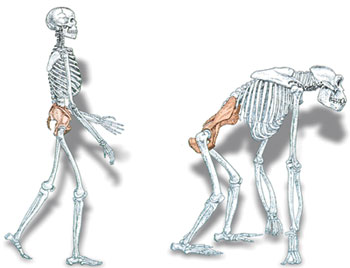 |
Recent researches reveal that it is impossible for the bent ape skeleton fit for quadrupedal stride to evolve into upright human skeleton fit for bipedal stride. |
Apart from the fossil record that we have dealt with so far, unbridgeable anatomical gaps between men and apes also invalidate the fiction of human evolution. One of these has to do with the manner of walking.
Human beings walk upright on two feet. This is a very special form of locomotion not seen in any other mammalian species. Some other animals do have a limited ability to move when they stand on their two hind feet. Animals like bears and monkeys can move in this way only rarely, such as when they want to reach a source of food, and even then only for a short time. Normally, their skeletons lean forward and they walk on all fours.
Well, then, has bipedalism evolved from the quadrupedal gait of apes, as evolutionists claim?
Of course not. Research has shown that the evolution of bipedalism never occurred, nor is it possible for it to have done so. First of all, bipedalism is not an evolutionary advantage. The way in which monkeys move is much easier, faster, and more efficient than man's bipedal stride. Man can neither move by jumping from tree to tree without descending to the ground, like a chimpanzee, nor run at a speed of 125 km per hour, like a cheetah. On the contrary, since man walks on two feet, he moves much more slowly on the ground. For the same reason, he is one of the most unprotected of all species in nature in terms of movement and defence. According to the logic of the theory of evolution, monkeys should not have evolved to adopt a bipedal stride; humans should instead have evolved to become quadrupedal.
Another impasse of the evolutionary claim is that bipedalism does not serve the "gradual development" model of Darwinism. This model, which constitutes the basis of evolution, requires that there should be a "compound" stride between bipedalism and quadrupedalism. However, with the computerised research he conducted in 1996, the English paleoanthropologist Robin Crompton, showed that such a "compound" stride was not possible. Crompton reached the following conclusion: A living being can either walk upright, or on all fours.100A type of stride between the two is impossible because it would involve excessive energy consumption. This is why a half-bipedal being cannot exist.
The immense gap between man and ape is not limited solely to bipedalism. Many other issues still remain unexplained, such as brain capacity, the ability to talk, and so on. Elaine Morgan, an evolutionist paleoanthropologist, makes the following confession in relation to this matter:
Four of the most outstanding mysteries about humans are: 1) why do they walk on two legs? 2) why have they lost their fur? 3) why have they developed such large brains? 4) why did they learn to speak?
The orthodox answers to these questions are: 1) 'We do not yet know'; 2) 'We do not yet know'; 3) 'We do not yet know'; 4) 'We do not yet know'. The list of questions could be considerably lengthened without affecting the monotony of the answers.101
  |
The myth of human evolution is based on no scientific findings whatsoever. Representations such as the above have no other significance than reflecting evolutionists’ imaginative wishful thinking. |
Lord Solly Zuckerman is one of the most famous and respected scientists in the United Kingdom. For years, he studied the fossil record and conducted many detailed investigations. He was elevated to the peerage for his contributions to science. Zuckerman is an evolutionist. Therefore, his comments on evolution can not be regarded as ignorant or prejudiced. After years of research on the fossils included in the human evolution scenario however, he reached the conclusion that there is no truth to the family tree in that is put forward.
Zuckerman also advanced an interesting concept of the "spectrum of the sciences", ranging from those he considered scientific to those he considered unscientific. According to Zuckerman's spectrum, the most "scientific"-that is, depending on concrete data-fields are chemistry and physics. After them come the biological sciences and then the social sciences. At the far end of the spectrum, which is the part considered to be most "unscientific", are "extra-sensory perception"-concepts such as telepathy and the "sixth sense"-and finally "human evolution". Zuckerman explains his reasoning as follows:
We then move right off the register of objective truth into those fields of presumed biological science, like extrasensory perception or the interpretation of man's fossil history, where to the faithful anything is possible - and where the ardent believer is sometimes able to believe several contradictory things at the same time.102
Robert Locke, the editor of Discovering Archeology, an important publication on the origins of man, writes in that journal, "The search for human ancestors gives more heat than light", quoting the confession of the famous evolutionist paleoantropologist Tim White: We're all frustrated by "all the questions we haven't been able to answer." 103
Locke's article reviews the impasse of the theory of evolution on the origins of man and the groundlessness of the propaganda spread about this subject:
Perhaps no area of science is more contentious than the search for human origins. Elite paleontologists disagree over even the most basic outlines of the human family tree. New branches grow amid great fanfare, only to wither and die in the face of new fossil finds.104
The same fact was also recently accepted by Henry Gee, the editor of the well-known journal Nature. In his book In Search of Deep Time, published in 1999, Gee points out that all the evidence for human evolution "between about 10 and 5 million years ago-several thousand generations of living creatures-can be fitted into a small box." He concludes that conventional theories of the origin and development of human beings are "a completely human invention created after the fact, shaped to accord with human prejudices" and adds:
To take a line of fossils and claim that they represent a lineage is not a scientific hypothesis that can be tested, but an assertion that carries the same validity as bedtime story-amusing, perhaps even instructive, but not scientific.105
What, then, is the reason that makes so many scientists so tenacious about this dogma? Why have they been trying so hard to keep their theory alive, at the cost of having to admit countless conflicts and discarding the evidence they have found?
The only answer is their being afraid of the fact they will have to face in case of abandoning the theory of evolution. The fact they will have to face when they abandon evolution is that Allah has created man. However, considering the presuppositions they have and the materialistic philosophy they believe in, creation is an unacceptable concept for evolutionists.
For this reason, they deceive themselves, as well as the world, by using the media with which they co-operate. If they cannot find the necessary fossils, they "fabricate" them either in the form of imaginary pictures or fictitious models and try to give the impression that there indeed exist fossils verifying evolution. A part of mass media who share their materialistic point of view also try to deceive the public and instil the story of evolution in people's subconscious.
No matter how hard they try, the truth is evident: Man has come into existence not through an evolutionary process but by Allah's creation. Therefore, he is responsible to Him.
71. David Pilbeam, "Humans Lose an Early Ancestor", Science, Nisan 1982, ss. 6-7![]()
72. Solly Zuckerman, Beyond The Ivory Tower, New York: Toplinger Publications, 1970, ss. 75-94![]()
73. Charles E. Oxnard, "The Place of Australopithecines in Human Evolution: Grounds for Doubt", Nature, Cilt 258, s. 389![]()
74. (Isabelle Bourdial, "Adieu Lucy", Science et Vie, Mayıs 1999, no. 980, s. 52-62)![]()
75. Holly Smith, American Journal of Physical Antropology, Cilt 94, 1994, ss. 307-325![]()
76. Fred Spoor, Bernard Wood, Frans Zonneveld, "Implication of Early Hominid Labryntine Morphology for Evolution of Human Bipedal Locomotion", Nature, cilt 369, 23 Haziran 1994, s. 645-648![]()
77. Tim Bromage, New Scientist, cilt133, 1992, s. 38-41![]()
78. J. E. Cronin, N. T. Boaz, C. B. Stringer, Y. Rak, "Tempo and Mode in Hominid Evolution", Nature, Cilt 292, 1981, s. 113-122![]()
79. C. L. Brace, H. Nelson, N. Korn, M. L. Brace, Atlas of Human Evolution, 2.b. New York: Rinehart and Wilson, 1979![]()
80. Alan Walker, Scientific American, vol 239 (2), 1978, s. 54![]()
81. Bernard Wood, Mark Collard, "The Human Genus", Science, vol 284, No 5411, 2 April 1999, pp. 65-71![]()
82. Marvin Lubenow, Bones of Contention, Grand Rapids, Baker, 1992, s. 83![]()
83. Boyce Rensberger, The Washington Post, 19 Kasım 1984![]()
84. Boyce Rensberger, The Washington Post, 19 Kasım 1984![]()
85. Richard Leakey, The Making of Mankind, London: Sphere Books, 1981, s. 62![]()
86. Marvin Lubenow, Bones of Contention, Grand Rapids, Baker, 1992. s. 136![]()
87. Pat Shipman, "Doubting Dmanisi", American Scientist, November- December 2000, p. 491![]()
88. Erik Trinkaus, "Hard Times Among the Neanderthals", Natural History, cilt 87, Aralık 1978, s. 10; R. L. Holloway, "The Neanderthal Brain: What Was Primitive", American Journal of Physical Anthropology Supplement, Cilt 12, 1991, s. 94![]()
89. Alan Walker, Science, cilt 207, 1980, s. 1103![]()
90. A. J. Kelso, Physical Antropology, 1st ed., New York: J. B. Lipincott Co., 1970, s. 221; M. D. Leakey, Olduvai Gorge, Cilt 3, Cambridge: Cambridge University Press, 1971, s. 272![]()
91. S. J. Gould, Natural History, Cilt 85, 1976, s. 30![]()
93. L. S. B. Leakey, The Origin of Homo Sapiens, ed. F. Borde, Paris: UNESCO, 1972, s. 25-29; L. S. B. Leakey, By the Evidence, New York: Harcourt Brace Jovanovich, 1974![]()
94. "Is This The Face of Our Past", Discover, Aralık 1997, s. 97-100![]()
95. A. J. Kelso, Physical Anthropology, 1.b., 1970, ss. 221; M. D. Leakey, Olduvai Gorge, Cilt 3, Cambridge: Cambridge University Press, 1971, s. 272![]()
96. D. C. Johanson & M. A. Edey, Lucy: The Beginnings of Humankind, New York: Simon & Schuster, 1981, s. 250![]()
97. Science News, Cilt 115, 1979, ss. 196-197![]()
98. I. Anderson, New Scientist, Cilt 98, 1983, s. 373![]()
99. R. H. Tuttle, Natural History, Mart 1990, ss. 61-64![]()
100. Ruth Henke, "Aufrecht aus den Baumen", Focus, Cilt 39, 1996, s. 178![]()
101. Elaine Morgan, The Scars of Evolution, New York: Oxford University Press, 1994, s. 5![]()
102. Solly Zuckerman, Beyond The Ivory Tower, New York: Toplinger Publications, 1970, s. 19![]()
103. Robert Locke, "Family Fights" Discovering Archaeology, July/August 1999, pp. 36-39![]()
104. Robert Locke, "Family Fights" Discovering Archaeology, July/August 1999, pp. 36![]()
105. Henry Gee, In Search of Deep Time, New York, The Free Press, 1999, s. 116-117![]()